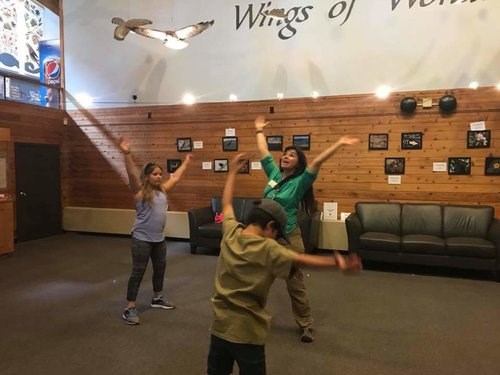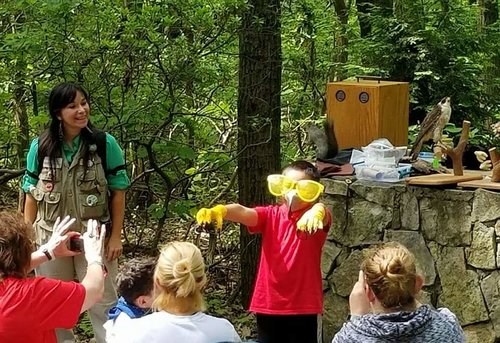Preserving Diversity in Education
Posted on in On the Mountain by Rachel Spagnola, Senior Educator
The world’s very first refuge for birds of prey attracts diverse individuals, and we welcome nature lovers, hikers, hawk watchers, native plant enthusiasts, autumn leaf peepers, and conservationists alike. Traditional school students explore our "school in the clouds" and eat lunch at North Lookout while eavesdropping on the hawk counters during the spring and autumn migration seasons. As a staff member, I’ve witnessed visitors become hypnotized by the magic of raptor migration, old friends reunite over trail mix, and first-time visitors fall in love with the landscape and our global mission. Every visitor encounter reminds me that Hawk Mountain Sanctuary is a very special place and how important it is to preserve special places.
Recently, several groups with special needs investigated the Mountain through an array of multisensory experiences. Students ranging in age from elementary to young adults from Saint Joseph’s Center for Special Learning located in Pottsville, Schuylkill County, and students with visual impairment from the Vision Resource Center of Berks County visited the Sanctuary. As a licensed elementary and special education teacher, my understanding of multiple intelligences, learning styles, and differentiated instruction allows me to offer accommodations that meet the needs of diverse learners.

The love of teaching and learning, enthusiasm and encouragement allows educators to provide special experiences. Hawk Mountain's programming is inspired to connect ALL visitors with Appalachian forest ecology, highlighting raptors as important bio-indicators of healthy ecosystems. To do this, students were offered an array of sensory experiences including touching feathers, snake skin, turtle shells, and mammal fur. We listened to recordings of the most commonly seen raptor in North America, the red-tailed hawk. Students listened while I waved wings of diurnal hawks in comparison to silent owl wings. Touching the feathered foot of a great-horned owl and carefully examining the scaly toes of a hawk allowed everyone to feel sharp and pointy talons and learn how they serve as tools for catching, gripping and killing prey. It amazed me how engaged everyone was for the entire presentation.
A stroll through the Native Garden offered sounds of green frogs, buzzing pollinators, and songbirds, before heading across the road for more outdoor exploration. Leaving the garden, we enjoyed the aroma of native swamp rose and the faint scent of sunscreen and insect repellant wafting by our group. Channeling our inner turkey vulture, we engaged our olfactory senses and, without hesitation, students shared their thoughts on smelling cigarette smoke and approval of smelling fresh baked bread. Several kids decided to give the turkey vulture a nickname: Bloodhound of the Sky. I approved.

Finally, we entered the accessible Silhouette Trail, connecting the trailhead to Laurelwood Niche and South Lookout, allowing all students to explore the ridgetop with ease. As a team, many navigated the trail with the help of wheelchairs and therapeutic personal assistants, others relied on canes or following the voice and arm leading them forward. Instead of ignoring the various tiny bumps and lumps under our feet and wheels, we examined tiny acorn caps, oak tree galls, and snail shells. These extraordinary students reminded me of the importance of appreciating the small things like looking out my window and seeing the lush, green leaves wave at me in the breeze. As we sat in peaceful silence at South Lookout, we felt the warmth of the sun peeking through the forest canopy and enjoyed breathing fresh, unpolluted mountaintop air. No one wanted to leave.
The students said that Hawk Mountain was their favorite place on earth, and I agreed. Every visit makes a difference, and we thank you for your continued support.